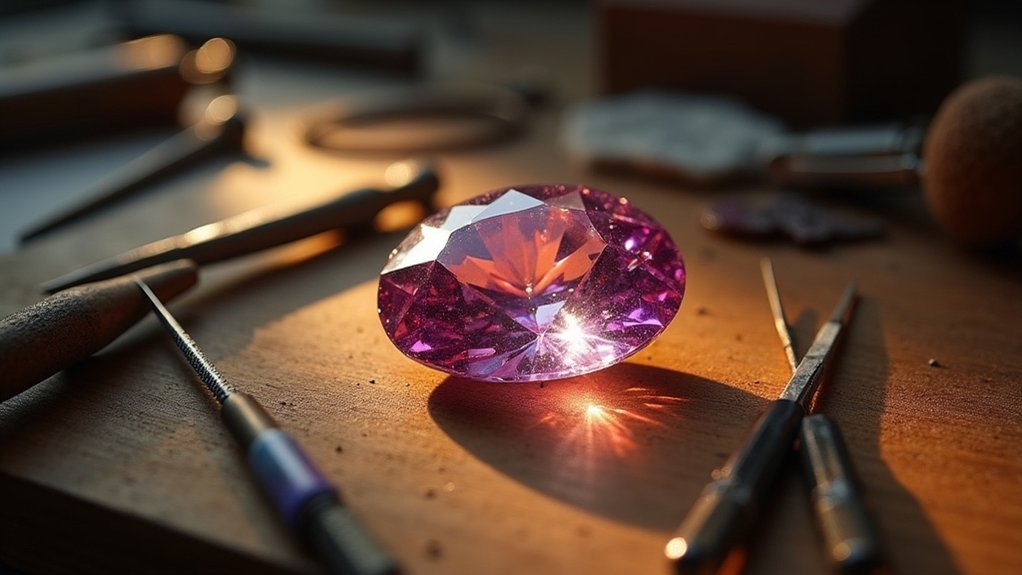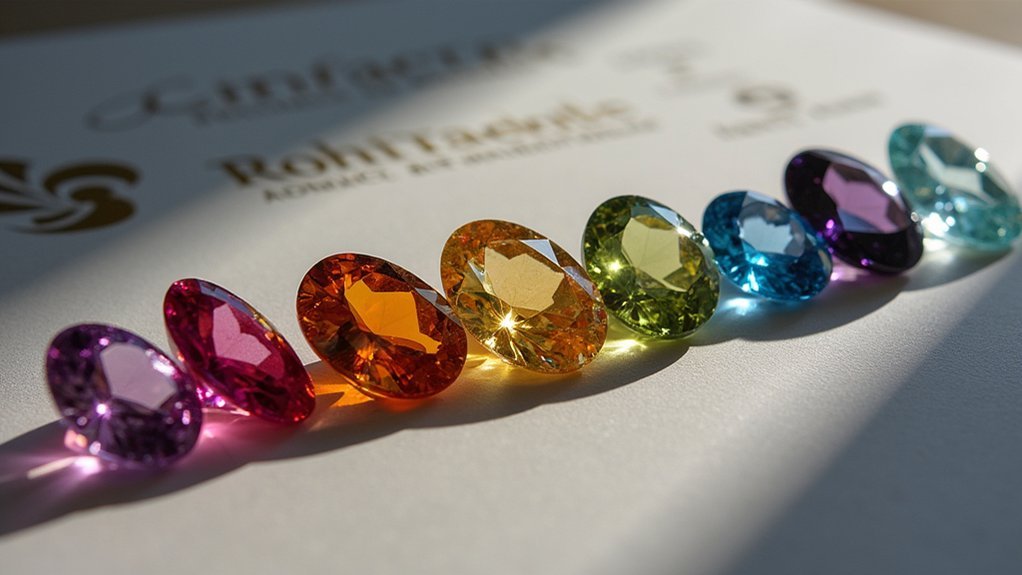You’ll find responsible gemstone cutting standards focus on ethical sourcing, environmental protection, and fair labor practices throughout the supply chain. Certification bodies like the Responsible Jewellery Council (RJC) verify compliance through rigorous assessments covering worker safety, waste reduction, and transparency from mine to market. These standards guarantee conflict-free sourcing, proper documentation, and sustainable cutting practices that reduce environmental impact by up to 90% through advanced technologies. Understanding these frameworks opens doors to deeper industry insights.
Understanding Responsible Gemstone Cutting Standards

When you purchase a gemstone, you’re not just buying a beautiful piece of jewelry—you’re supporting an entire supply chain that affects communities worldwide.
Understanding responsible gemstone cutting standards helps you make informed decisions that promote ethical sourcing and sustainability.
Informed gemstone purchasing decisions drive ethical sourcing practices and promote sustainable industry standards throughout the global supply chain.
These standards encompass extensive guidelines covering environmental protection, worker safety, and fair compensation throughout the cutting process.
You’ll find that certification bodies like the Responsible Jewellery Council implement rigorous code of practices assessments to verify compliance.
Responsible cutting involves complete supply chain transparency, enabling you to trace your gemstone’s journey from mine to market.
Companies must demonstrate adherence to social justice principles while maintaining environmental stewardship.
This transparency addresses growing consumer demand for ethically produced jewelry while ensuring your purchase supports positive industry practices.
The Role of Certification Bodies in Ethical Practices
You’ll find that certification bodies like the Responsible Jewellery Council establish extensive standards that reshape how gemstone cutting operations approach ethical practices.
When you’re evaluating a gemstone supplier, understanding their certification assessment process reveals whether they truly meet rigorous human rights, labor, and environmental requirements.
These certifications don’t just provide credibility—they create measurable industry benefits that drive transparency and accountability throughout your supply chain.
RJC Standards Overview
While the gemstone industry has historically faced challenges with ethical sourcing and transparency, the Responsible Jewellery Council (RJC) has emerged as a leading force in establishing thorough standards that transform how businesses approach responsible practices.
You’ll find that RJC’s ethical standards encompass detailed guidelines covering human rights, labor conditions, and environmental sustainability throughout the jewelry supply chain.
The RJC offers three essential certification frameworks:
- Code of Practices (COP) – Establishes fundamental ethical standards for responsible business operations
- Chain of Custody (COC) – Guarantees traceability and responsible sourcing throughout supply chains
- Laboratory Grown Materials (LGMS) – Provides specific guidelines for synthetic gemstone production
- UN Sustainable Development Goals alignment – Connects industry practices with global sustainability objectives
These standards require rigorous third-party assessments, guaranteeing your commitment to accountability enhances brand reputation.
Certification Assessment Process
Building on these thorough RJC frameworks, certification bodies play a pivotal role in verifying that companies actually implement these standards in practice.
You’ll find that these organizations conduct rigorous assessments throughout your gemstone supply chain operations. They’ll evaluate your human rights practices, labor conditions, and environmental impact against established ethical guidelines.
During certification, you’ll need to provide extensive documentation and undergo on-site audits. These assessments examine every aspect of your operations, from mining through retail.
You’ll receive detailed compliance reports indicating your certification status or highlighting areas requiring improvement.
Achieving certification enhances your market reputation and demonstrates your commitment to ethical practices. This transparency builds consumer trust and positions your company as a responsible industry leader.
Industry Impact Benefits
Since certified gemstone cutting companies demonstrate measurable compliance with ethical standards, they’re experiencing significant competitive advantages across multiple market segments.
When you obtain certification from certification bodies like the RJC, you’ll reveal tangible benefits that directly impact your business performance and market position.
The industry-wide benefits include:
- Enhanced Brand Reputation – You’ll build stronger consumer trust through verified responsible practices
- Market Differentiation – Your certification sets you apart from non-certified competitors
- Supply Chain Transparency – You’ll attract partners who prioritize ethical sourcing
- Regulatory Compliance – You’ll meet evolving international standards proactively
These advantages translate into measurable outcomes: increased customer loyalty, access to premium markets, and sustainable business growth that aligns with consumer demand for ethically sourced jewelry.
Environmental Impact Assessment in Cutting Operations
When you’re conducting environmental impact assessments for your cutting operations, you’ll need to focus on three critical areas that directly affect your facility’s sustainability performance.
You must implement thorough waste reduction strategies that minimize material loss and properly handle hazardous byproducts from your cutting processes.
Additionally, you’ll want to establish robust monitoring systems for energy consumption and optimize your water usage through recycling and efficient distribution methods.
Waste Reduction Strategies
While traditional gemstone cutting often prioritizes maximizing carat weight over efficiency, you’ll find that modern waste reduction strategies can dramatically transform your environmental footprint.
These sustainable practices aren’t just environmentally responsible—they’re economically smart too.
Here are four essential waste reduction approaches for your cutting operations:
- Optimization algorithms – Implement advanced software to minimize raw material loss, achieving up to 30% waste reduction during cutting processes.
- Water recycling systems – Install closed-loop systems that can reduce water consumption by over 60% while preventing pollution.
- CNC machinery – Use computer-controlled cutting equipment for enhanced precision and better raw gemstone utilization.
- Circular economy practices – Reuse gemstone dust and off-cuts to create a sustainable workflow that aligns with RJC standards.
Energy Consumption Monitoring
Although energy consumption monitoring might seem like an administrative task, you’ll discover it’s actually a powerful tool for dramatically reducing your cutting operation’s environmental impact.
By tracking electricity and water usage, you can identify inefficiencies that cost money and harm the environment. Implementing energy-efficient technologies can slash your consumption by up to 30%, considerably lowering your carbon footprint.
The Responsible Jewellery Council encourages members to monitor and report energy usage, promoting transparency throughout the supply chain.
You’ll find that switching to renewable energy sources like solar or wind reduces fossil fuel dependence. Regular energy audits reveal improvement opportunities, enabling you to implement targeted strategies that enhance efficiency and sustainability while maintaining cutting quality standards.
Water Usage Optimization
As gemstone cutting operations consume between 300 to 600 gallons of water per carat, you’ll need to prioritize water usage optimization to minimize your environmental impact on local water resources.
Implementing effective water usage optimization requires strategic environmental practices:
- Install closed-loop water systems that can reduce freshwater consumption by up to 90% through recycling and reuse.
- Adopt advanced cutting technologies like laser cutting to minimize water usage while maintaining precision compared to conventional methods.
- Conduct regular environmental impact assessments to evaluate how water optimization reduces pollution risks from wastewater.
- Monitor water quality and usage consistently to guarantee compliance with sustainability standards set by organizations like the Responsible Jewellery Council.
These environmental practices don’t just conserve precious water resources—they’ll also help you meet certification requirements while reducing operational costs.
Fair Labor Practices and Worker Safety Requirements
When you’re working in gemstone cutting, ensuring fair labor practices and worker safety isn’t just ethical—it’s essential for sustainable business operations.
You’ll need to meet Responsible Jewellery Council standards, which require safe working conditions, fair wages, and reasonable hours for all workers.
To achieve RJC certification, you must implement thorough health and safety protocols. This includes proper ventilation systems, protective equipment, and worker training programs that minimize cutting-related health risks.
You’re also required to prohibit child labor and forced labor in your facilities.
Regular audits will assess your compliance with these standards, ensuring ongoing accountability.
Traceability Through the Cutting Process

While maintaining ethical labor practices forms the foundation of responsible cutting, establishing thorough traceability systems guarantees you can document each gemstone’s complete journey through your facility.
These systems enable verification of ethical sourcing and processing practices that consumers increasingly demand.
Effective traceability implementation requires:
- Detailed record maintenance following RJC standards, documenting each stone’s path from mine to finished product
- Certification partnerships with bodies like GIA and IGI to provide extensive grading reports including origin information
- Blockchain technology integration for real-time tracking that increases transparency and accountability
- Environmental and labor documentation proving your commitment to reducing impact while promoting fair conditions
This extensive approach creates a responsible supply chain that builds consumer trust and supports ethical sourcing verification.
Quality Control and Ethical Compliance Measures
Since effective traceability systems create the foundation for accountability, you’ll need thorough quality control and ethical compliance measures to validate your responsible cutting practices.
Your quality control processes must rigorously assess cut, clarity, color, and carat weight to meet industry standards and consumer expectations.
You should pursue Responsible Jewellery Council certification, which mandates responsible practices throughout your supply chain from cutting to retail.
Your facility must demonstrate transparency in sourcing and processing, ensuring ethical sourcing of all gemstones while maintaining conflict-free status.
You’ll need continuous training programs for your artisans in both cutting techniques and ethical practices.
This investment maintains high-quality standards while promoting social responsibility, allowing consumers to verify their stones’ origins and trust your commitment to responsible practices.
Supply Chain Transparency for Cut Gemstones

Although quality control measures establish your cutting standards, supply chain transparency for cut gemstones requires you to document and disclose every stage of each stone’s journey from mine to finished product.
You’ll need extensive tracking systems that verify ethical sourcing practices throughout your entire supply chain.
Modern transparency initiatives provide several verification methods:
- RJC Certification – Proves your compliance with responsible sourcing standards through rigorous third-party auditing
- Blockchain Technology – Enables real-time tracking of gemstones from extraction to final sale
- Kimberley Process Certification – Guarantees your stones are conflict-free and don’t finance violence
- Documentation Requirements – Maintains detailed records of mining origins, labor practices, and environmental impact
These transparency measures protect your reputation while ensuring consumers can trust your gemstones’ ethical origins.
Benefits of Certified Responsible Cutting for Stakeholders
Establishing these transparency frameworks creates tangible benefits that extend across all stakeholders in your gemstone supply chain.
When you invest in certified responsible cutting, you’re ensuring ethical labor practices that protect worker rights and guarantee fair wages. Your environmental commitment becomes evident as certification demonstrates minimal ecological damage during processing.
Certified responsible cutting ensures ethical labor practices, fair wages, and demonstrates your commitment to minimal environmental impact during gemstone processing.
You’ll gain enhanced brand reputation and consumer trust, as RJC Certification signals your dedication to responsible sourcing and transparent operations.
These gemstone certifications open new market opportunities, meeting growing consumer demand for ethically processed stones. Your certified practices strengthen overall supply chain accountability, reinforcing ethical standards from mine to retail.
This all-encompassing approach positions you advantageously in today’s increasingly conscious marketplace while contributing to industry-wide responsibility.
Global Standards and Industry Best Practices

When you’re maneuvering the complex world of gemstone cutting, understanding global standards becomes vital for maintaining ethical operations. The Responsible Jewellery Council (RJC) leads industry-wide standards, establishing thorough frameworks that address ethical, social, and environmental practices throughout your supply chain.
You’ll implement these key best practices for responsible sourcing:
- Transparency in sourcing – Document your gemstone origins and supply chain partners
- Non-toxic materials usage – Eliminate harmful chemicals in cutting processes
- Fair labor practices – Guarantee safe working conditions and proper compensation for artisans
- Kimberley Process compliance – Verify your gemstones are conflict-free
Advanced technologies now enhance traceability and sustainability in your operations.
You’re meeting growing consumer demand for ethically sourced products while maintaining RJC certification standards that guarantee accountability across human rights, labor practices, and environmental impact.
Frequently Asked Questions
Which Certification Is Best for Gemstones?
You’ll find GIA certification’s the gold standard for diamonds, offering unmatched credibility. For colored gemstones, you should consider ICA certification. AGS works well if you’re prioritizing cut quality, while GSI provides budget-friendly options.
How to Get a Gemstone Certificate?
You’ll submit your gemstone to a reputable lab like GIA, IGI, or AGS. They’ll analyze its characteristics using specialized tools, then issue a certificate documenting authenticity, quality, and treatments for $50-several hundred dollars.
How Much Does It Cost to Certify a Gemstone?
You’ll pay $50 to several hundred dollars for gemstone certification, depending on your stone’s value and analysis complexity. More valuable gemstones cost more, while different institutes offer varying pricing structures.
What Is Gems Certification?
Gems certification’s your gemstone’s official verification process. You’ll receive a detailed report documenting authenticity, quality, and characteristics like color, clarity, cut, and carat weight. It’s fundamentally your stone’s passport proving its genuine identity and value.
In Summary
You’ve seen how responsible gemstone cutting standards transform the industry through rigorous certification, environmental protection, and worker safety protocols. When you choose certified cut gemstones, you’re supporting transparent supply chains and ethical practices that benefit miners, cutters, and consumers alike. These global standards aren’t just guidelines—they’re your assurance that beauty doesn’t come at the expense of people or planet. Make your next purchase count.





Leave a Reply